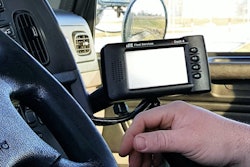 Driver Bob Stanton (second from right) and Landstar-leased owner-operator Charles Alexander (right) were among participants in the ELD-issues panel of drivers convened by FMCSA at the Great American Trucking Show.
Driver Bob Stanton (second from right) and Landstar-leased owner-operator Charles Alexander (right) were among participants in the ELD-issues panel of drivers convened by FMCSA at the Great American Trucking Show.What will happen in situations where your electronic logging device documents an unavoidable violation? This could be driving beyond limits while looking for a parking spot in a congested area or moving from a parking place during an off-duty period when forced to by local law enforcement.
State and federal law enforcement officials urge drivers to practice blunt honesty, using annotations on duty statuses and status changes to explain the situation in detail. In many cases, officer leniency is likely to prevail.
Before e-logs, “getting the load there on time was the first priority,” said driver Bob Stanton, part of a panel convened by the Federal Motor Carrier Safety Administration during the Great American Trucking Show in August 2017. Before, “you made your log look legal” only after that first priority was met, he said. Now, if there’s any chance you can’t get deliver within legal hours, you need to make the appropriate calculations well beforehand.
That seemingly simple change, however, is one that brings with it a raft of complications, from new administrative and operational burdens placed on drivers and carrier dispatch to the pressing need for shipper/receiver customers’ appreciation of the new dynamics.

Others at the GATS panel presented cases, including delays at shippers and receivers that exhaust on-duty hours. FMCSA enforcement specialist LaTonya Mimms noted officers will retain the discretion on whether to write a violation.
Download the full ELD Buyers’ Guide

Click here to download the full version of the Overdrive ELD Buyers’ Guide, updated with how your business can choose an ELD for your business.
If the overage is “no more than 15 minutes,” Mimms said, the “trooper may or may not cite a nominal hours violation,” with little consequence for safety scores. In excess of 15 minutes, however, a normal violation would be the typical response.
Two-truck independent Rico Muhammad has encountered such a situation, parked overnight outside a receiver’s closed facility, staged to unload in the morning. Run off by local law enforcement during his off-duty period, he used personal conveyance mode in his e-log (which continues the off-duty status when selected) to move five miles up the road to a spot.
Joe DeLorenzo, director of FMCSA’s Office of Enforcement and Compliance, hears about special cases all the time, many having to do with just where personal conveyance is warranted or not. He emphasizes that it’s properly understood as truly personal use of the vehicle. Traveling to and from shipping/receiving locations isn’t the place to use it, though compliance consultants have argued otherwise, particularly for self-dispatched or independent owner-operators such as Muhammad (if empty).
When an exceedingly lengthy delay at the shipper or receiver causes the driver’s 14-hour clock to run out, DeLorenzo says proceeding to a safe haven/parking location/truck stop would not be considered personal conveyance. Rather, he urges drivers to make the trip and annotate the circumstances “in case somebody asks for it,” thus avoiding charges of a “false log” for incorrect personal conveyance use. If the shipper forces you to leave and violate the regulation, you can also utilize the stipulations of the anti-driver coercion rule, published in tandem with the ELD mandate, to report the shipper to the DOT and encourage enforcement action, part of new authority the agency has over the shipping community. Find how to file a complaint via nccdb.fmcsa.dot.gov.
In December, FMCSA proposed to remove the requirement to be “unladen” from the definition of personal conveyance. A final adoption of such or similar guidance could come as early as June.
DeLorenzo also clarifies the other special short-term driving category specified in the ELD rule: yard move. Using this category will move a driver to the on-duty not-driving status, even though the vehicle is in motion. Just where it can be used hasn’t been fully understood to date throughout the industry.
DeLorenzo says fleet terminals aren’t the only places where it’s OK to use; it’s also good within facilities away from public roads such as ports, railyards, customer locations and the like. At distances of no more than three to five miles, DeLorenzo says, “it’s OK. If it starts to accumulate more than that, people are going to start asking questions.”
Yard moves, after being categorized by the driver or registered automatically in a geofenced area, must be approved by the administrator. In the case of an independent, that makes use of the yard move a two-step process for the owner.
Self-incrimination by ELD will rise to the level of a violation only if someone decides that it does. Picky violations in special circumstances, says Capt. Brian Preston of the Arizona Department of Public Safety, are not going to get many in much trouble if they’re logged honestly. What his officers are looking for, he says, is more the intent to deceive.











